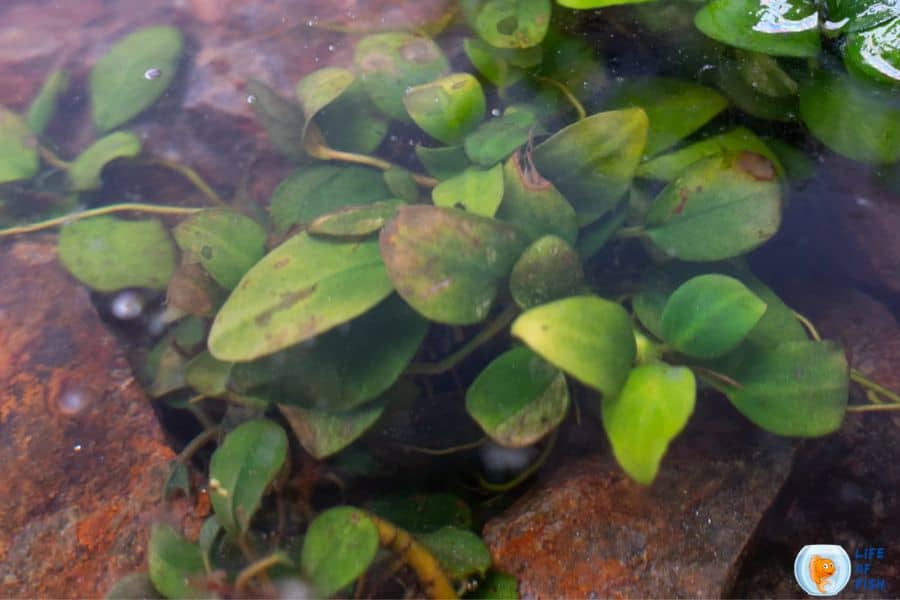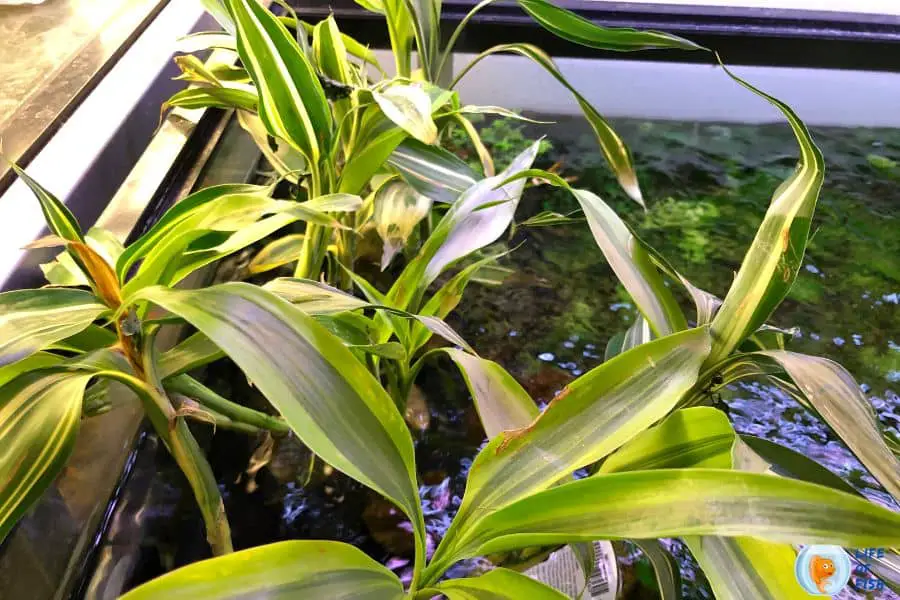Many hobbyists prefer live aquarium plants over other decorations because they provide natural filtration, oxygenation, and hiding places for fish. Unfortunately, live plants can also be a source of trouble in the aquarium. Some common problems include algae growth, aquarium plants melting, and dying plants.

One of the most frustrating problems that aquarium hobbyists face is when their live plants begin to melt.
This can be caused by many factors, including improper lighting, nutrient deficiencies, and injuries. If you’re struggling with a melting plant problem, here are a few tips that may help.
Why Did My Aquarium Plants Melt?
Jump To
Aquarium plants can melt due to various reasons. However, we categorized several reasons into four main groups.
01. Damages
The first group includes problems with the plant itself. This can include anything from damaging the plant during shipping to poor-quality plants. If the plant has been damaged, it may not be able to recover and will begin to melt.
Another way the plant gets damaged is when fish or other pests nibble on the leaves. This can cause holes in the leaves, which will eventually lead to the plant melting.
Usually, when plants get damaged, the damaged segments lose their ability to photosynthesize properly. This means that the plant can’t produce the food it needs to survive and will begin to die back and melt.
02. Nutrient Deficiencies
The second group of reasons has to do with nutrient deficiencies. Aquarium plants need various nutrients to stay healthy, including nitrogen, phosphorus, potassium, iron, and carbon.
If the plant lacks any of these nutrients, it will become stressed and begin to melt.
One of the most common nutrient deficiencies is iron. Iron is essential for plant growth but is also one of the easiest nutrients to deplete in an aquarium. This is because iron is very soluble and easily removed through filtration.
If your plants lack iron, they will usually begin to develop yellow leaves. These leaves will eventually die and fall off, causing the plant to melt.
Other nutrient deficiencies can also cause melting plants. For example, a lack of nitrogen can cause the leaves to turn brown and die. A lack of potassium can cause the leaves to become pale and weak.
03. Improper Lighting
The third group of reasons has to do with improper lighting. Aquarium plants need a certain amount of light to photosynthesize and create food. If the plants are not getting enough light, they will begin to stress and melt.
There are a few different ways to tell if your plants are not getting enough light. The first is by looking at the leaves. If the leaves are small and pale, it’s a sign that the plant isn’t getting enough light.
Another way to tell if the plant isn’t getting enough light is by looking at the stem. If the stem is thin and spindly, it’s a sign that the plant isn’t getting enough light.
Finally, you can also tell if a plant isn’t getting enough light if it’s not growing. If the plant isn’t growing, it’s likely because it’s not getting enough light.
04. Transition Of The Plant/ Establishing The Plant
When you first add a plant to your aquarium, it’s going through a lot of changes. The plant is adjusting to its new environment and trying to establish itself. During this time, the plant may melt a little bit.
This is normal and shouldn’t be cause for alarm. The plant will usually recover and start to grow again once it’s established. If the plant does not recover, it is most likely due to one of the other reasons on this list.
How Do You Tell If Your Aquarium Plants Are Dying?
There are a few different ways to tell if your aquarium plants are dying. The first is by looking at the leaves. If the leaves are brown or yellow, it’s a sign that the plant is dying.
You may also use the stem to determine if the plant is dead. If the stem is thin and spindly, it’s a sign that the plant is dying.
Finally, you may determine whether a plant is alive or dead by looking for a change in its activity. If the plant isn’t growing, it’s probably dead or dying.

Will Melted Aquarium Plants Grow Back?
In most cases, melted aquarium plants will grow back. However, there are a few factors that will determine whether the plant will be able to recover.
- The severity of the melting. If the plant has only melted a little bit, it’s more likely to recover than if it has melted a lot.
- The cause of the melting. If a nutrient deficiency causes the melting, it’s more likely that the plant will be able to recover. However, if the melting was caused by something like improper lighting, it’s less likely that the plant will be able to recover.
- The health of the plant before it melted. If the plant was healthy before melting, it’s more likely to recover. However, it’s less likely to recover if the plant was already sick or dying before it melted.
Should I Remove Melting Plants?
Seeing some melted leaves or stems in your plant isn’t necessarily cause for alarm. In most cases, the plant will recover and start growing again. However, there are a few situations where you may want to remove the plant.
The plant is melting a lot.
If the plant is melting a lot, you may want to remove it. A plant that is melting a lot is more likely to die than a plant that is only melting a little bit.
The plant is sick or dying.
If the plant is sick or dying before it melts, you may want to remove it. A plant already sick or dying is less likely to recover from melting.
The plant is causing problems for other plants.
If the plant is causing problems for other plants, you may want to remove it. A plant that is melting may release toxins that can harm other plants.
The plant doesn’t get enough light.
If the plant is in an area that isn’t getting enough light, you may want to remove it. A plant that isn’t getting enough light is more likely to die than a plant that is getting enough light.
How To Prevent Aquarium Plants Melting
The most effective way to keep plants from melting is to maintain them healthily and in the best possible condition. Here are some specific things we can do to help:
Maintain a healthy aquarium
A healthy aquarium means an aquarium with clean water that is cycled and has the correct pH, hardness, and temperature. Ammonia, nitrites, and nitrates should be at 0 ppm so fish and plants can thrive.
Plants indeed absorb these nutrients to grow well. But, if the nutrient levels are too high, they can also cause your plants to melt and die (which can happen when you do not maintain a healthy aquarium).
When your aquarium is cycled correctly, the nitrifying bacteria will take care of the ammonia and nitrites. You can then do water changes to remove the nitrates before they reach toxic levels.
Plants usually grow well in cycled aquariums, especially if they contain nutrient-rich soil.
Use the correct lighting.
Different plants need different amounts of light. It’s essential to research the lighting requirements of the specific plant species you want to grow.
If you give your plants too much light, they can get stressed and start to melt. If you give your plants too little light, they can also get stressed and begin to melt. The key is finding the sweet spot where your plants are getting the right amount of light.
You can experiment with different lighting schedules to see what works best for your plants. For example, you could try giving your plants 12 hours of light per day for a week and then increasing the amount of light by an hour each week until you find the perfect lighting schedule.
Trim/ prune the plant often
If a plant is getting too big, it can start to melt. When you trim or prune a plant, you remove the parts that are getting too big. This can help the plant to stay healthy and stop it from melting.
It would help if you trimmed or pruned your plants every few weeks. Be sure to research the specific plant species you are growing to know how often to trim or prune them.
Fertilize the plant
Fertilizing your plants can help them to grow well and stay healthy. However, it’s important not to over-fertilize your plants. Over-fertilization can cause your plants to melt.
It would help if you fertilized your plants every two weeks with plant fertilizer. Be sure to research the specific plant species you are growing to know how often to fertilize them.
Avoid moving plants
Aquarium plants require some time to establish themselves in the substrate. If you move your plant often, it doesn’t get a chance to settle down.
Your plant will have to re-establish its root system in the new spot. As we mentioned, melting can happen when a plant tries to establish itself.
It’s best to choose a spot for your plant and leave it there. If you need to move your plant, be sure to do it slowly so that the plant has time to adjust.
Supplement with CO2
Aquarium plants have a hard time getting the carbon they need to grow. This is because the levels of dissolved CO2 in aquariums are usually low.
One way to help your plants get the carbon they need is to supplement with CO2. There are many different ways to do this. One way is CO2 injection. CO2 injection is when you add CO2 to your aquarium water with a CO2 regulator. This can help your plants to grow well and avoid melting.

How To Save Melting Aquarium Plants?
If you’ve noticed that your aquarium plants are slowly melting, don’t worry – it’s not always an irreversible process. There are some things you can do to try to rescue your plants and prevent further melting.
- Remove dead leaves and decaying plant matter.
Remove any dead leaves or decaying plant matter from the water as soon as you see it. This will help prevent ammonia levels from rising, contributing to plant melting.
- Cycle the water in the tank
Cycling the water in your tank will help ensure that the water parameters are optimal for your plants. This includes things like the water’s pH, temperature, and hardness.
- Add liquid fertilizer
Adding liquid fertilizer to the water can help supplement the nutrition your plants are getting from the substrate.
- Improve Oxygen and Carbon dioxide levels
Making sure that the Oxygen and Carbon dioxide levels in your tank are optimal can help your plants cope better with stressors like plant melting.
Conclusion
Aquarium plants melting is a common problem that you can often reverse. By taking some proactive steps, like removing dead leaves and decaying plant matter, cycling the water, and adding liquid fertilizer, you can help improve the situation and prevent further melting.
Read Next : Salvinia Turning White ( What Should I Do? )
